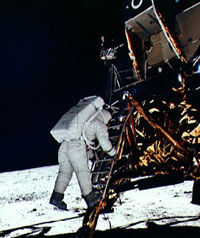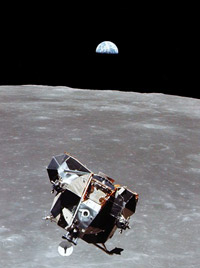
The Astrophysics Spectator
On this day 35 years ago Neil Armstrong and Buzz Aldrin took their first steps on the surface of the moon, achieving the first part of president John F. Kennedy's challenge to NASA of landing a man on the moon and bringing him safely home.

Apollo 11 begins its voyage, powered by a Saturn 5 rocket. Photo credit: Courtesy NASA.
The program to place man on the moon preceeded Kennedy in office. Less than a year after its inception on October 1, 1968, NASA had selected its first astronaut corp, and it had achieved its first manned space-flight success with the suborbital flight of Allen Shepard on May 5, 1961. But the earlier success of the Soviet space program in placing Yuri Gagarin into orbital flight in April of 1961 spurred the new president to propose increased spending for the space program. In this address to a joint session of congress on May25, Kennedy said "Finally, if we are to win the battle that is now going on around the world between freedom and tyranny, the dramatic achievements in space which occurred in recent weeks should have made clear to us all, as did the Sputnik in 1957, the impact of this adventure on the minds of men everywhere, who are attempting to make a determination of which road they should take." Kennedy then proposed spending to achieve four goals, with the first being "the goal, before this decade is out, of landing a man on the moon and returning him safely to the earth." (The second goal was the development the Rover nuclear rocket, and the third and forth goals were the creation of communication and weather satellite systems).
The program progressed steadilly, advancing from the Mercury program with its single-man capsule to Gemini with its two-man capsule. Not all flights went well, but disaster was adverted on the several occasions that the space capsule malfunctioned. The only major setback to the program occurred on January 27, 1967 with the deaths of Gus Grissom, Roger Chaffee, and Ed White in a capsule fire during a launch pad test of Apollo 1 (it was designated this after the fire). But this was still the era of the test pilot, and such fatalities were accepted as part of the cost of reaching the moon. Following several unmanned flights, man returned to space with Apollo 7 on October 11, 1968.
The next achievement of the Apollo program was the Apollo 8 flight to the moon in December of 1968. This was the first Apollo flight with the Saturn 5 booster. The capsule flew to the moon without a lunar lander; its goal was to reach the moon, orbit it, and return. While orbiting the moon, the crew of that mission read to the world a passage from Genesis on Christmas eve. The photographs from this mission of the earth rising above the moon became immediately famous. Apollo 8 brought a sense that the tragedy of Apollo 1 had been left behind.
The Apollo 11 mission was the moon landing mission. It launched on the morning of July 16 with Neil Armstrong as commander and a crew of Buzz Aldrin and Michael Collins.

Photograph by Neil Armstrong of Buzz Aldrin descending the steps of the Eagle Lunar Excursion Modual (LEM) to the Moon's surface. Photo credit: Courtesy NASA.
On July 20, the lunar module carried Neil Armstrong and Buzz Aldrin to the lunar surface, leaving Michael Collins behind to tend the command module. The landing was carried live. Television viewers heard Armstrong slowly count down the altitude, and then, after a long pause, Armstrong calmly said "Houston, Tranquility Base here. The Eagle has landed" at 20:17 GMC (16:17 EDT).
The moon walk was carried on live television, with images provided by a camera mounted on the outside of the LEM. The world watched blurry black-and-white images of Armstrong slowly descending the ladder on the LEM's landing strut. After a slight pause, he hopped to the lunar surface, and in a somewhat halting manner recited his line "That's one small step for man, one giant leap for mankind." He was shortly followed by Buzz Aldrin. They planted the American flag, set out scientific experiments, drilled core samples, and collected rocks, which lead to the important scientific result that the moon is composed of material that originally was in the earth's mantle. But such tasks were secondary to their primary task: to be the first humans to step on the moon.

The LEM rendezvous with the command module after leaving the moon. Photo credit: Courtesy NASA.
The astronauts spent less than a day on the moon, and Armstrong and Aldrin spent 2 hours and 32 minutes and 1 hour 50 minutes respectively ouside of the LEM. The upper portion of he LEM left the lunar surface at 17:54 of July 21, and after docking with the command module. Early on July 22 the command module left lunar orbit, and on July 24 Apollo 11 landed back on earth.
This was the high point of manned space flight. The flights to the moon came to an end in December of 1972 with the flight of Eugene Cernan, Ronald Evans, and Jack Schmitt on Apollo 17, and with them NASA went into a period of decline. Over the past 35 years many more milestones in manned space flight have been reached, but none have equaled the first landing on the moon in its impact on our imaginations.
